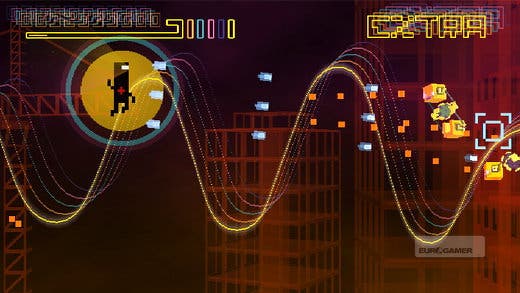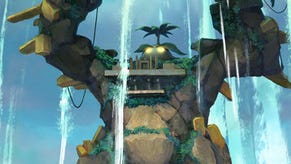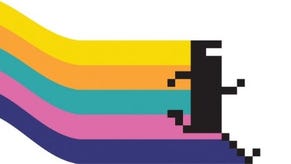Bit.Trip Saga Review
Pixel n' mix.
Mini-game compilation. Two words that can make the blood run cold, tainted as they are with the fetid stench of cheap, cynical shovelware, created solely to bilk a few coins from the purses of gamers too naïve and inexperienced to know what they're doing.
It doesn't have to be that way, of course, as this collected edition of the popular Bit.Trip series proves.
Developed by Californian outfit Gaijin Games and previously released digitally across various formats including PC, WiiWare and iOS, Bit.Trip is something of a standard-bearer for the neo-retro indie movement. The series combines the savage difficulty and chunky visuals of early '80s gaming with pulsing chiptune music and a healthy sprinkling of ironic charm. Bit.Trip Saga collects all the games for the 3DS; a companion edition, Bit.Trip Complete, does the same for Wii [see sidebar, below left].
There are six games in the series, ostensibly telling the story of the rectangular Commander Video, but don't feel too dismayed if you find the 'narrative' difficult to pin down. This is 'story' in the oldest, most abstract arcade sense of the word, little more than a handful of sentences to give some human impetus to the rhythmic action. "You have to do this because that's what you do" is as deep as it goes.

Bit.Trip Beat is the first of the six, and the one that most clearly sets the aesthetic tone. Essentially a trippy hybrid of Pong and Rez, you use your paddle to rebound a stream of incoming "beats", with each impact adding a chime to the throbbing soundtrack.
Complications quickly arise as beats arrive in greater number and at escalating speed, although colour-coding tips you off as to what they'll do. Some will etch sine waves across the screen as they head your way, others will drift in slowly, pause and then rocket forward. Yet more will fade in and out of view entirely The only way to repel the onslaught is to let the music guide you, its metronome beat telling you when to expect a beat at your threshold.
Beat also introduces a feature that recurs in most of the other titles: Nether. This monochrome underworld is where you end up should your performance in the game become less than satisfactory. The music fades out, everything is starkly black and white, and only by regaining your rhythm can you earn your way back into the scoring zone.

Bit.Trip Core keeps things in the minimalist retro style, putting you and your d-pad in control of a four-way laser. Once again, your goal is to stop beats from passing across the screen, this time by zapping them as they pass. Once beats are flying in all four directions it's an absolutely dizzying experience, and one that only the nimblest fingers will survive.
Bit.Trip Void changes the style, casting you as a circular black void. Black and white beats stream towards you; collecting black makes you expand while hitting white erases your multiplier and drops you back to normal size. The game becomes a pull and push as you grow as large as possible before manually shrinking to squeak past otherwise unavoidable white beats. Marginally less hectic than the previous games, it also runs out of inspiration far sooner.
Bit.Trip Runner is the first in the series to resemble any kind of recognisable action game, as Commander Video makes his first on-screen starring appearance. It's a reaction test in the 'endless runner' mould, as the Commander pegs it through a scrolling terrain, and it's up to you to jump, slide and kick your way through without mistakes, collecting as much gold as you can. Make a single mistake, however, and it's all the way back to the start. It's arguably the most mainstream and fully featured entry in the series, so it's no surprise that this is the one that will be getting a more fleshed out sequel later this year.

Bit.Trip Fate finds the Commander entering shoot-'em-up territory with an undulating twist. Confined to a rising and falling rail, you can only control his movement left and right, while using the stylus to fend off attacks from bullet-spewing enemies. Restricted as you are, dodging these projectiles means shuttling backwards and forwards along the rail, finding temporary safety in a peak or trough.
Finally, Bit.Trip Flux brings everything full circle, returning to the gameplay of Beat with some minor tweaks. The game is flipped, so beats travel left to right, and the colour coding has been removed, making it much harder to predict the behaviour of each beat. The game does offer checkpoints this time, which is about as accommodating as the series gets.
All these games are good to great, depending on your tolerance for retina-straining pace and punitive design. Once you find the pulse of each game, they're incredibly moreish, and none of them are so long that the frequent resets back to the start feel too overwhelming.
What the games have gained in the move to 3DS is, of course, that extra layer of visual depth, and it's particularly well suited to both the hypnotic background patterns and the brisk, bold slabs of colour floating on top. Compared to more graphically complex 3DS games this is a relative breath of fresh air, with little blurring or confusion. And it works in harmony with the style of play as well; just as the music and gameplay draw you in, so the screen stretches into the distance to heighten the effect.
The hardware shift brings problems as well, sadly. Control is the main issue, thanks to the change from Wii remote to 3DS pad. A distracting stickiness to the paddle movement in Bit.Trip Beat makes playing with the circle pad a chore, although the stylus alternative is better. Similarly, Bit.Trip Fate suffers from having to use the stylus on the lower screen in order to shoot on the top screen. The visual disconnect between the two makes accuracy troublesome, and on the later stages that can be a real handicap.
Also losing Bit.Trip Saga points are the rather skimpy features compared to its Wii companion. The 3DS version is very much a bare-bones affair, with the six games launched from a stark opening menu and nothing else. The games are what's important, of course - but when you can get them all on the Wii with tons of bonus material and control schemes designed for that native platform, it can't help but make Saga look like a second best option.
That shouldn't detract from what are, ultimately, six delightfully inventive games. Bit.Trip's carefully poised fusion of old-school difficulty and retro-futuristic aesthetics won't be to everyone's taste, but anyone with an interest in distilled arcade design owes it to themselves to at least have a go, and this compilation makes that easier than ever. Fans will find that the whole never quite proves worthy of its individual parts, though.












